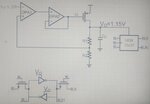wjxcom
Full Member level 5
Hi all, I am designing a LDO which can as a power supply for SRAM. The following picture is the construction of the LDO.
There have two OPA, i.e. OPA1 and OPA2. Now the frequency of reading and writing SRAM is 60MHz, There have some questions:
1.How can I confirm the GBW of OPA1 and OPA2?
2.How can I confirm the GAIN of OPA1 and OPA2?
3.OPA1 and OPA2 are two 2-stage OPAs that have mill compensation, what's the influence of the main poles on the LDO?

Help me please, thanx!!
There have two OPA, i.e. OPA1 and OPA2. Now the frequency of reading and writing SRAM is 60MHz, There have some questions:
1.How can I confirm the GBW of OPA1 and OPA2?
2.How can I confirm the GAIN of OPA1 and OPA2?
3.OPA1 and OPA2 are two 2-stage OPAs that have mill compensation, what's the influence of the main poles on the LDO?

Help me please, thanx!!